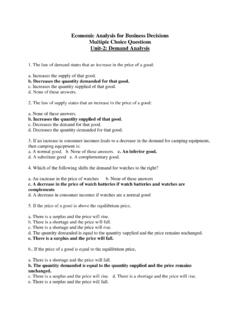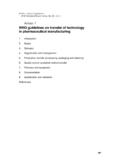Transcription of Unit 1 : Management Information System A) DSS B) MIS C ...
1 Unit 1 : Management Information System Q. 1. Information systems that monitor the elementary activities and transactions of the organizations are : A) Management -level System B) Operational-level, System C) Knowledge-level System D) Strategic level System Ans: A Q. 2. Projections and responses to queries are Information output characteristics associated with: A) DSS B) MIS C) ESS D) TPS Ans: C Q. 3. Summary transaction data, high-volume data, and simple models are Information Inputs characteristic of: A) DSS B) MIS C) ESS D) TPS Ans: B Which of the following individuals typically have less formal, advanced educational degrees and tend to process rather than create Information ? A) Knowledge workers B) Executives C) System analysts D) Data workers Ans: D Q. 5. Management Information systems usually: A) Serve managers interested in weekly, monthly, and yearly results, not day-to-day activities.
2 B) Help managers make decisions that are unique, rapidly changing, and not easily specified in advance. C) Provide managers with a generalised computing and telecommunications capacity that can be applied to a changing array of problems. D) Perform and record the daily routine transactions necessary to the conduct of business. Ans: A Q. 6. Identifying customers and markets using data on demographics, markets, consumer behaviour, and trends is an example of : A) Operational-level sales and marketing Information System . B) Knowledge-level sales and marketing Information System . C) Management -Level sales and marketing Information System . D) Strategic-level sales and marketing Information System Ans: B Deciding where to locate new production facilities is an example of a manufacturing and production Information System operating at the: a) Operational level b) Management level c) Knowledge level d) Strategic level Ans: D Q.
3 8. Preparing short-term budgets is an example of a finance and accounting Information System operating at the: a) Operational level b) Management level c) Knowledge level d) Strategic level Ans: D Q. 9. Tracking employee training, skills, and performance appraisal is an example of a human resource Information System operating at the: A) Operational level B) Management level C) Knowledge level D) Strategic level Ans: A Q. 10. Assembling a product, identifying customers and hiring employees are : A) Transactions B) Phases C) Business Processes D) Business Functions Ans: C Materials into intermediate and finished products, and distributing the finished products to customers? A) Production Chain B) Primary Chain C) Supply Chain D) Distribution chain Ans: C Q. 12. Information systems can facilitate supply chain Management by: A) Tracking the status of orders.
4 B) Rapidly communicating orders, C) Providing product specifications. D) none all of the above. Ans: D Q. 13. Enterprise systems support: A) Manufacturing processes. B) Financial and accounting processes. C) Human resource processes. D) All of the above. Ans: D Q. 14. A computer security protocol for logging in would be an example of the component of an Information System : A) software B) hardware C) Data D) Procedure Ans: D Q. 15. Customer numbers and their names would be an example of the _____ component of an order Management Information System . A) software B) hardware C) data D) procedure Ans: C Q. 16. The quality of your _____ is a large part of the quality of your Information System . A) computer B) thinking C) time D) challanges Ans: B Q. 17. Which of the following is not a characteristic of good Information ?
5 A) Interchangeability B) relevance C) cost effectiveness D) timeliness Ans: A Q. 18. If you are a _____ recipient of sensitive Information such as might be overheard or contained in a misdirected email, this would not be legal, but-might be unethical to use it . A) active B) Passive C) proper D) business Ans: B A human order taker can be bypassed when using .. A) Office automation System B) Management Information System C) Transaction processing System D) Decision support System Ans: C Q. 20. Data mining cannot be done if _____ A) operational data has not been archived B) earlier Management decisions are not available C) the organisation is large D) all processing had been only batch processing Ans: A Q. 21. On-line transaction processing is used when _____ I) it is required to answer random queries ii) it is required to ensure correct processing iii) all files are available on-line Iv) all files are stored using hard disk.
6 A) i, ii B) i, iii C) ii, iii, iv D) i, jj ,iii Ans: B Q. 22. Which is not a domain of-Artificial Intelligence? A) Intelligent Agents. B) Expert System . C) None of the above. D) A & B Ans: D Q. 23. Which computer based model is developed after human brain? A) Fuzzy Logic 8) Neural Network C) Virtual-Reality D) All of the above Ans: B Q. 24. Knowledge based System supports, _____ A) Knowledge of creation. B) Knowledge of support. C) Knowledge of Dissemination. D) All of the above. Ans: D Q: 25. Which of the System uses Multidimensional data analysis? A) DSS B) MIS C) ESS D) All of the above Ans: A Q. 26. Cybernetic System is the one which is _____ A) Self Monitoring. B) Self controlling. C) Self regulating. D) All Of the above. Ans: D Q. 27. Which of the following are the inputs of Marketing Information System ?
7 I) Marketing research data II) Marketing intelligence data ii) External environment data iv) strategic plan A) Only I, ii, and iii. B) Only ii, iii and iv. C) Only i, iii and iv. D) All I, ii, iii and iv. Ans: D Q. 28. _____ is the process of defining the current problem, determining why a new System is needed, identifying the objectives of the proposed System : A) Feasibility analysis B) System Analysis C) System definition D) System requirements , Ans: C Q. 29. The accounting System is _____ whereas the demand forecasting System is _____. A) deterministic, probabilistic B) probabilistic, deterministic C) open, close D) close, open Ans: A Q. 30. _____ Systems keep a track on the daily regular business transactions of the organisation. A) Management -level B) Strategic-level C) Executive Information D) Operational-level Ans: D Q.
8 31. In which of the following functions of MIS reports are generated based on the enterprise's need'? A) Planning B) Prediction, C) Data Processing D) Data storage Ans: A Q. 32. EIS provide highly unstructured Information to the level Management for long term decision making. A) Operational B) Bottom C) Middle D) Top Ans: D Q. 33. Which of the following Information category is used by middle Management ? A) Organisational B) Functional managerial knowledge C) Decision support D) Operational Ans: C Q. 34. _____ e-commerce applications use EDI over the secure Virtual private network. A) C2C : (Customer to CusJomer) B) C2B (Customer to Business Organisation) C) B2C (Business Organisation to Customer) D) B2B (Business Organisation to Business) Ans: D Q. 35. _____ focuses on researching how the human brain does work and, how human beings imagine.
9 A) Cognitive science B) Robotics C) Natural interfaces D) Artificial intelligence Ans: A _____ makes use of groupware technology on Internet platform for faster response Processing. A) E-Communication B) E-business C) E-commerce D) E-collaboration Ans: C Q. 37. The-popular term for the software component that supports the collaborative efforts of a team is- A) videoconferencing software B) work flow automation software C) groupware D) none of above Ans: C Q. 38. EDI stands for: A) Electronic data interchanqe B) Electrical data interchange C) work flow automation software D) Enhanced data interchange Ans: A Q. 39. The direct, computer-to-computer exchange of standardized, common business transaction documents between business partners, suppliers, and customers is _____ A) EDI B) ES C) EIS D) ERP Ans: A Q.
10 40. MIS stands for _____ A) Management internet System . B) Marketing Internet System . C) Marketing and implementation software. D) Management Information System . Ans: D Q. 41. The Management Information System receives input from the: A) EIS. B) ES. C) DSS. D) TPS Ans: D Q. 42. The _____ provides a manager with the Information needed to make decisions regarding, the firm's operational activities. A) ElS B) ES C) MIS D) EDl Ans: C Q. 43. A combination of a MIS and DSS called _____ which helps top managers make decisions. A) GIS B) EIS C) EPI D) CAM Ans: B Q. 44: The first phase of IT planning is called _____ planning A) tactical B) project C) organisational D) strategic Ans : D Q. 45. Which of these items is a major component of today's IT infrastructure?















